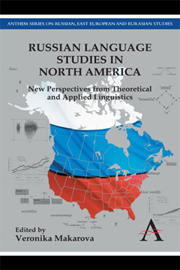Book contents
- Frontmatter
- Contents
- List of Tables and Figures
- Introduction
- Part One Language Structures and their Interface
- 1 Phonetics. Tracing Emotions in Russian Vowels
- 2 Phonology. Vowel–Zero Alternations in Russian Prepositions: Prosodic Constituency and Productivity
- 3 Morphology and Lexicology Interface. Latest Russian Neologisms: The Next Step towards Analytism?
- 4 Syntax. Bi-nominative Sentences in Russian
- 5 Psycholinguistics. The Effect of Grammatical Gender in Russian Spoken-Word Recognition
- Part Two Applied Linguistic and Sociolinguistic Analysis
- Afterword
- Index
2 - Phonology. Vowel–Zero Alternations in Russian Prepositions: Prosodic Constituency and Productivity
from Part One - Language Structures and their Interface
Published online by Cambridge University Press: 05 November 2012
- Frontmatter
- Contents
- List of Tables and Figures
- Introduction
- Part One Language Structures and their Interface
- 1 Phonetics. Tracing Emotions in Russian Vowels
- 2 Phonology. Vowel–Zero Alternations in Russian Prepositions: Prosodic Constituency and Productivity
- 3 Morphology and Lexicology Interface. Latest Russian Neologisms: The Next Step towards Analytism?
- 4 Syntax. Bi-nominative Sentences in Russian
- 5 Psycholinguistics. The Effect of Grammatical Gender in Russian Spoken-Word Recognition
- Part Two Applied Linguistic and Sociolinguistic Analysis
- Afterword
- Index
Summary
Introduction
Many Russian prepositions have two realizations, with and without the final vowel. For example, s ‘with,’ k ‘to’ and iz ‘from’ sometimes appear as so, ko, and izo, respectively. Sometimes only the consonant-final variant is possible, such as v(*o) dome ‘in the house,’ s(*o) drugom ‘with a friend,’ etc. Sometimes, both versions are acceptable: v(o) sne ‘in sleep/dream,’ s(o) množestvom ‘with many.’ In some cases, the variant with the final vowel predominates, such as ko mne ‘to me,’ so mnoj ‘with me.’
In this chapter, I investigate the conditions determining the choice between the variants with and without the vowel -o (which surfaces as either [a] or [a], and is called a “yer,” as explained below), and relate those conditions to syntactic and semantic factors, as well as to other aspects of Russian phonology, most notably the behavior of stress.
The discussion below is couched in standard generative phonology (Halle 1959; Chomsky and Halle 1968; Lightner 1972). In this framework, underlying (phonemic) forms are related to surface forms via a series of transformations, also known as rules or processes, which affect the features and segments of the representations. The standard Chomsky-Halle framework is enriched by the theory of prosodic hierarchy (Selkirk 1984; Hayes 1989). The sequence of segments is understood to form a hierarchy of constituents of progressively increasing size – syllable, stress foot, prosodic word, and phrase. In this chapter, only syllables and prosodic words will be relevant.
- Type
- Chapter
- Information
- Russian Language Studies in North AmericaNew Perspectives from Theoretical and Applied Linguistics, pp. 43 - 70Publisher: Anthem PressPrint publication year: 2012
- 3
- Cited by



